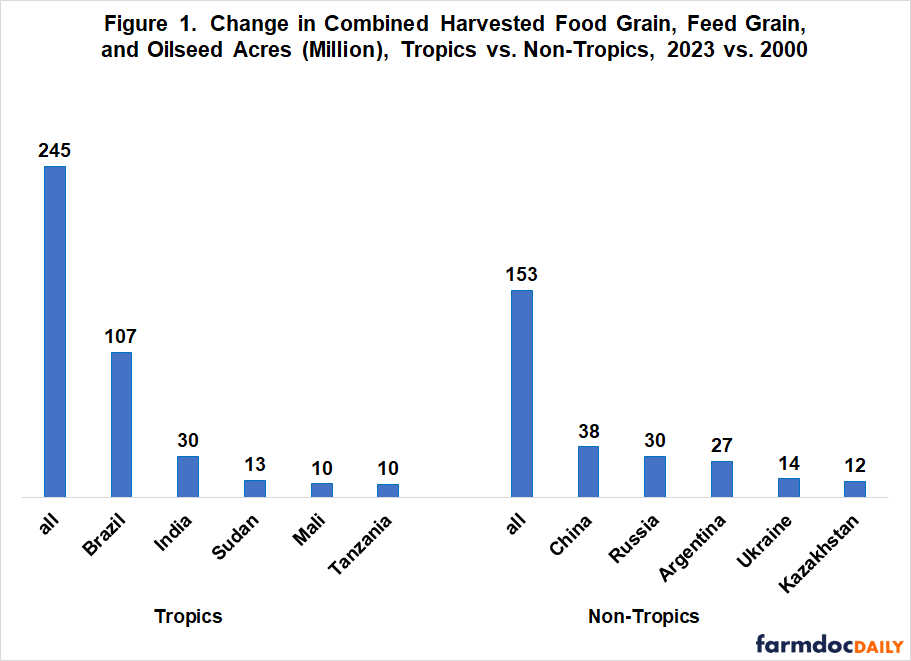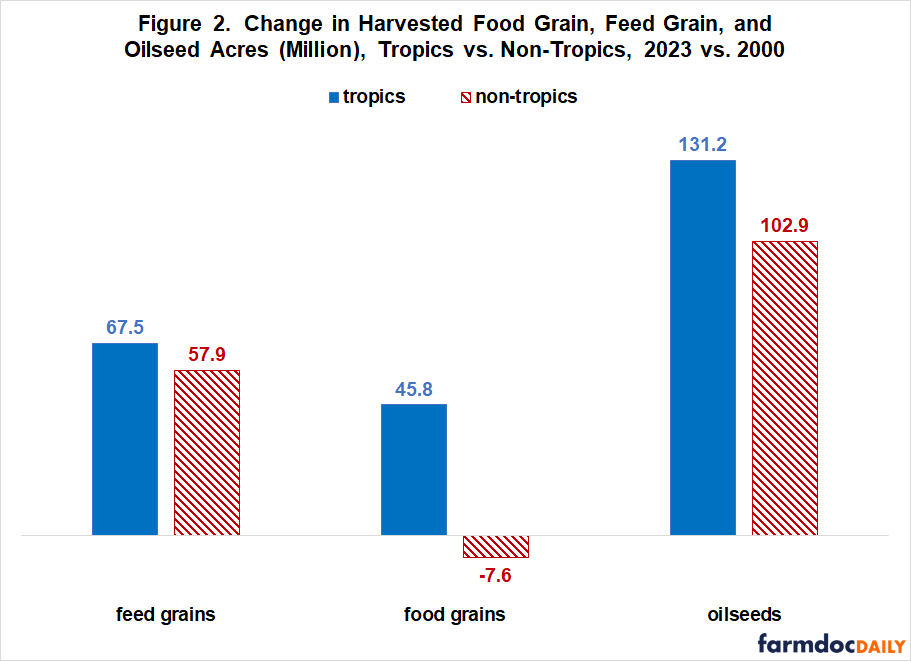Brazil’s past expansion and potential to further expand cropland has received considerable attention in the US (see farmdoc daily, April 9, 2024). In the 21st century, however, Brazil has accounted for only 27% of the world’s expansion of crop land. As illustrated in this article, a broader viewpoint is that cropland is expanding throughout the tropics. Only with significant changes in its production technology will the US benefit from this expansion.
21st Century Cropland Expansion
The world has added 398 million harvested acres of feed grains, food grains, and oilseeds during the 21st Century (see Figure 1). Sixty-two percent were in tropical countries. Brazil’s share is 27% for the world and 44% for tropical countries. After Brazil and India, the three tropical countries adding the most acres were Sudan, Mali, and Tanzania in Sub-Sahara Africa. China added the most acres among non-tropical countries, but the former Soviet Union countries of Russia, Ukraine, and Kazakhstan collectively added more acres, 57 million. In contrast, the US harvested 4 million fewer acres of feed grains, food grains, and oilseeds in 2023 than in 2000. The data and procedures used to generate Figure 1 and the rest of the analysis in this article are described at the end of this article.

Tropical countries added more acres than non-tropical countries in each field crop group – feed grains, food grains, and oilseeds (see Figure 2). The largest difference was in food grains, where acres increased by 45.8 million in tropical counties but decreased by 7.6 million in non-tropical countries. World output of agricultural products, including livestock, has also moved south (Fuglie, Morgan, and Jelliffe, 2024).

Discussion
It is conventional to focus on the role of yield in increasing crop output, but during the 21st Century increased land has accounted for at least one-third of the increase in feed grain, food grain, and oilseed output (farmdoc daily, March 6, 2024). Without land expansion, crop prices would be much higher.
Moreover, while Brazil attracts lots of attention, to focus on Brazil means seeing less than half of the picture. Brazil accounts for 27% of the increase in cropland in the world and 44% in the tropics.
A more appropriate perspective is that Brazil is leading a shift in cropland to the tropics. This shift opens up a synergy with multiple cropping of an individual acre / hectare. For example, the April 9, 2024 farmdoc daily suggests that up to 40 million acres could be added in Brazil by further expanding the double cropping of corn after soybeans.
The US is unlikely to participate in any major way in the expansion of multiple cropping without a major change in its crop genetics and production technology. When combined with the lack of increase in US feed grain, food grain, and oilseed acres during the crop prosperity of the 21st Century due in part to policy, US crop agriculture faces key strategic disadvantages moving forward unless it reinvents its production of crops.
Data
The data in this article are from the PSD (Production, Supply, and Distribution Online) database (US Department of Agriculture, Foreign Agriculture Service). The 21st Century perspective of this article lead to the use of the 2000 and 2023 crop years. In PSD, feed grains are barley, corn, millet, oats, and sorghum; food grains are rice, rye, and wheat; and oilseeds are cottonseed, peanuts, rapeseed, soybeans, and sunflowers.
Tropical countries were identified using the classification by World Population Review. Their classification identifies fully tropical and partly tropical countries. Partly tropical counties included as tropical countries for this article are Bangladesh, Brazil, and India. Description of these countries at multiple sites indicated that the overwhelming majority of their agricultural lands were in tropical areas.
Assuming the approach described in the preceding paragraph, tropical countries in the PSD data set are Angola, Bangladesh, Benin, Brazil, Burkina-Faso, Burundi, Cambodia, Cameroon, Central African Republic, Cabo Verde, Chad, Cote d’Ivorie, Colombia, Congo (Brazzaville), Congo (Kinshasa), Costa Rica, Cuba, Dominican Republic, Ecuador, El Salvador, Eritrea, Ethiopia, Gambia, The; Ghana, Guatemala, Guinea, Guinea-Bissau, Guyana, Haiti, Honduras, India, Indonesia, Jamaica, Laos, Kenya, Mali, Malaysia, Malawi, Mauritania, Nicaragua, Niger, Nigeria, Panama, Peru, Philippines, Rwanda, Senegal, Sierra Leone, Somalia, Sri Lanka, Sudan, Suriname, Tanzania, Thailand, Togo, Trinidad and Tobago, Uganda, Venezuela, Vietnam, Yemen, and Zambia.
farmdoc daily Articles in this Series
Colussi, J., N. Paulson, G. Schnitkey, C. Zulauf and J. Baltz. “Potential for Crop Expansion in Brazil Based on Pastureland and Double-Cropping.” farmdoc daily (14):69, Department of Agricultural and Consumer Economics, University of Illinois at Urbana-Champaign, April 9, 2024.
Zulauf, C., J. Colussi, N. Paulson and G. Schnitkey. “Assessing US Performance: Land and 21st Century Field Crop Production.” farmdoc daily (14):46, Department of Agricultural and Consumer Economics, University of Illinois at Urbana-Champaign, March 6, 2024.
Zulauf, C., J. Colussi, N. Paulson and G. Schnitkey. “Exploring Yield Growth: US Crops in a Global 21st Century Context.” farmdoc daily (14):56, Department of Agricultural and Consumer Economics, University of Illinois at Urbana-Champaign, March 20, 2024.
Zulauf, C., J. Colussi, G. Schnitkey, N. Paulson and D. Orden. “Land, not Exports, is the US Field Crop Problem – Part 1, US vs. World.” farmdoc daily (14):65, Department of Agricultural and Consumer Economics, University of Illinois at Urbana-Champaign, April 3, 2024.
Zulauf, C., G. Schnitkey, N. Paulson and J. Colussi. “Concentration of US Crops in Corn and Soybeans: Importance to Increasing US Production of Grains and Oilseeds.” farmdoc daily (13):173, Department of Agricultural and Consumer Economics, University of Illinois at Urbana-Champaign, September 22, 2023.
Zulauf, C., J. Colussi, G. Schnitkey and N. Paulson. “Agricultural Land Shifts to the Tropics: A Strategic Challenge for US Crops.” farmdoc daily (14):73, Department of Agricultural and Consumer Economics, University of Illinois at Urbana-Champaign, April 17, 2024.
Other References for This Article
Fuglie, K.O., Morgan, S., & Jelliffe, J.(2024. World agricultural production, resource use, and productivity, 1961–2020. (Report No. EIB-268. U.S. Department of Agriculture, Economic Research Service.
US Department of Agriculture, Foreign Agriculture Service. April 2024. Production, Supply, and Distribution Online. https://apps.fas.usda.gov/psdonline/
World Population Review. April 2024. https://worldpopulationreview.com/country-rankings/tropical-countries

 Change in land use 2023 versus 2000
Change in land use 2023 versus 2000



